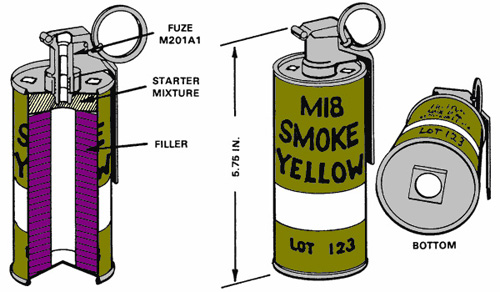 This used colored-smoke grenade was originally housed in the type of container posted yesterday. Indeed, the two may have been a couple as both were found in the Dry Valleys, albeit by different individuals at different times. Ironically, the paper container's label survived to tell us of its contents while the steel grenade relinquished all its identifying marks to the elements, including the top surface hue that originally indicated its smoke color. The Army/Navy Model 18 Colored Smoke Grenade, as the M18 is officially known, has various uses both in training and combat. In pacific settings such as Antarctica, it can function to signal aircraft and/or to mark a target landing zone. Having experienced the Dry Valleys fog, I'll guess that this device dutifully served to guide a helicopter safely to base back in the relatively nascent days of GPS technology.
This used colored-smoke grenade was originally housed in the type of container posted yesterday. Indeed, the two may have been a couple as both were found in the Dry Valleys, albeit by different individuals at different times. Ironically, the paper container's label survived to tell us of its contents while the steel grenade relinquished all its identifying marks to the elements, including the top surface hue that originally indicated its smoke color. The Army/Navy Model 18 Colored Smoke Grenade, as the M18 is officially known, has various uses both in training and combat. In pacific settings such as Antarctica, it can function to signal aircraft and/or to mark a target landing zone. Having experienced the Dry Valleys fog, I'll guess that this device dutifully served to guide a helicopter safely to base back in the relatively nascent days of GPS technology.  Image source: Wikimedia Commons Some technical details for the curious: The M18 is a burning-type grenade which burns oxygen. A pull-ring igniter activates the fuze which detonates the filler, creating pressure to force the smoke out through the emission hole at the bottom. Weighing 19 ounces, the device can typically be thrown 115 feet (35 meters) and its 11.5 ounces of filler generates a cloud of colored smoke for a duration of 50 to 90 seconds. Some history on its early manufacture from the Redstone Arsenal Chronology: 16 November 1943: The first M-18 colored smoke grenade (violet) was produced at Huntsville Arsenal on this date. Production continued until 8 May 1945. Persons working in colored smoke were paid one grade higher to offset the danger involved in the manufacture of these munitions; to compensate for the dusty conditions under which they worked; and to make up for the staining of the employees’ skin. The higher wage scale applied to all of the different colored smoke operations.
Image source: Wikimedia Commons Some technical details for the curious: The M18 is a burning-type grenade which burns oxygen. A pull-ring igniter activates the fuze which detonates the filler, creating pressure to force the smoke out through the emission hole at the bottom. Weighing 19 ounces, the device can typically be thrown 115 feet (35 meters) and its 11.5 ounces of filler generates a cloud of colored smoke for a duration of 50 to 90 seconds. Some history on its early manufacture from the Redstone Arsenal Chronology: 16 November 1943: The first M-18 colored smoke grenade (violet) was produced at Huntsville Arsenal on this date. Production continued until 8 May 1945. Persons working in colored smoke were paid one grade higher to offset the danger involved in the manufacture of these munitions; to compensate for the dusty conditions under which they worked; and to make up for the staining of the employees’ skin. The higher wage scale applied to all of the different colored smoke operations.